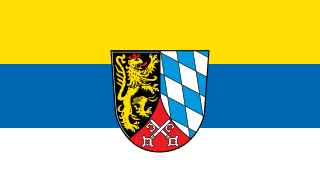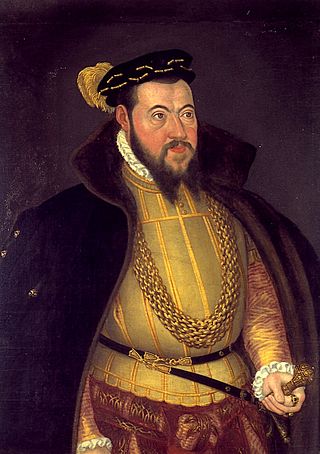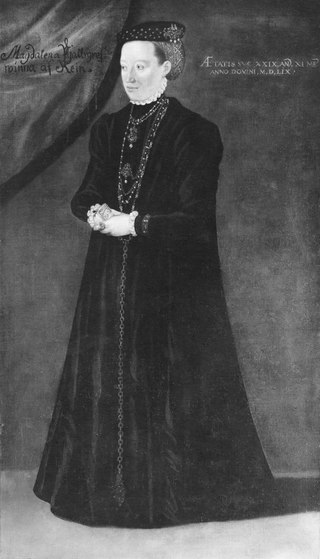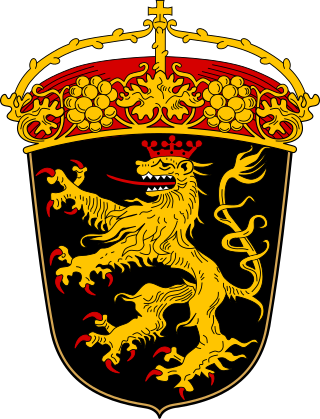Palatinate or county palatine may refer to:
Contents
- the territory or jurisdiction of a count palatine
Palatinate or county palatine may refer to:

Rupert of the Palatinate, sometimes known as Robert of the Palatinate, a member of the House of Wittelsbach, was Elector Palatine from 1398 and King of Germany from 1400 until his death.

The Electoral Palatinate or the Palatinate, officially the Electorate of the Palatinate, was a constituent state of the Holy Roman Empire. The electorate had its origins under the rulership of the Counts Palatine of Lotharingia in 915; it was then restructured under the Counts Palatine of the Rhine in 1085. From 1214 until the Electoral Palatinate was merged into the Kingdom of Bavaria in 1805, the House of Wittelsbach provided the Counts Palatine or Electors. These counts palatine of the Rhine would serve as prince-electors from "time immemorial", and were noted as such in a papal letter of 1261; they were confirmed as electors by the Golden Bull of 1356.

The House of Wittelsbach is a former Bavarian dynasty, with branches that have ruled over territories including the Electorate of Bavaria, the Electoral Palatinate, the Electorate of Cologne, Holland, Zeeland, Sweden, Denmark, Norway, Hungary, Bohemia, and Greece. Their ancestral lands of Bavaria and the Palatinate were prince-electorates, and the family had three of its members elected emperors and kings of the Holy Roman Empire. They ruled over the Kingdom of Bavaria which was created in 1805 and continued to exist until 1918.

The Upper Palatinate is an administrative district in the east of Bavaria, Germany. It consists of seven districts and 226 municipalities, including three cities.
Pfalz, Pfälzer, or Pfälzisch are German words referring to Palatinate.

The House of Palatinate-Zweibrücken, a branch of the Wittelsbach dynasty, was the ruling dynasty of Sweden from 1654 to 1720.

Stephen of Simmern-Zweibrücken was Count Palatine of Simmern and Zweibrücken from 1410 until his death in 1459.

The House of Palatinate-Simmern was a German-Bavarian cadet branch of the House of Wittelsbach. The house was one of the collateral lineages of the Palatinate. It became the main branch in 1559.

The Duchy of Palatinate-Zweibrücken was a duchy of the Holy Roman Empire with full voting rights to the Reichstag. Its capital was Zweibrücken. The reigning house, a branch of the Wittelsbach dynasty, was also the Royal House of Sweden from 1654 to 1720.

Count Palatine Wolfgang of Zweibrücken was member of the Wittelsbach family of the Counts Palatine and Duke of Zweibrücken from 1532. With the support of his regent, his uncle Rupert, Wolfgang introduced the Reformation to Zweibrücken in 1537.
Sulzbach or Sülzbach may refer to:
Palatinate-Neumarkt was a subdivision of the Wittelsbach dynasty of the German Electoral Palatinate. Its capital was Neumarkt in der Oberpfalz.

Joseph Charles, Hereditary Prince of Sulzbach was the eldest son of Theodore Eustace, Count Palatine of Sulzbach.

The House of Palatinate-Birkenfeld, later Palatinate-Zweibrücken-Birkenfeld, was the name of a collateral line of the Palatine Wittelsbachs. The Counts Palatine from this line initially ruled over only a relatively unimportant territory, namely the Palatine share of the Rear County of Sponheim; however, their importance steadily grew. All living members of the House of Wittelsbach descend from Palatinate-Birkenfeld, which thus became the parent branch of the Kings of Bavaria.
Palatinate-Simmern and Zweibrücken was a state of the Holy Roman Empire based in the Simmern and Zweibrücken in modern Rhineland-Palatinate, Germany.

Duke Wilhelm in Bavaria, full German name: Wilhelm, Herzog in Bayern was Count Palatine of Birkenfeld-Gelnhausen between 1789 and 1799 and first Duke in Bavaria from 16 February 1799 until his death in 1837. From 17 December 1803 to 20 March 1806, Wilhelm was titled Duke of Berg.
The district duchy, also known as the district principality, was a type of the state under the patrimonial system, such as duchy or principality, formed in the feudal system, as a result of land partition between the members of a royal family. It occurred in the Middle Ages and early modern period, notably in Europe, in states such as the Holy Roman Empire, Duchy of Poland, and Kievan Rus'.

Anna of Hesse was a princess of Hesse by birth and marriage Countess Palatine of Zweibrücken.

The Palatine Lion, less commonly the Palatinate Lion, is an heraldic charge. It was originally part of the family coat of arms of the House of Wittelsbach and is found today on many coats of arms of municipalities, counties and regions in South Germany and the Austrian Innviertel.